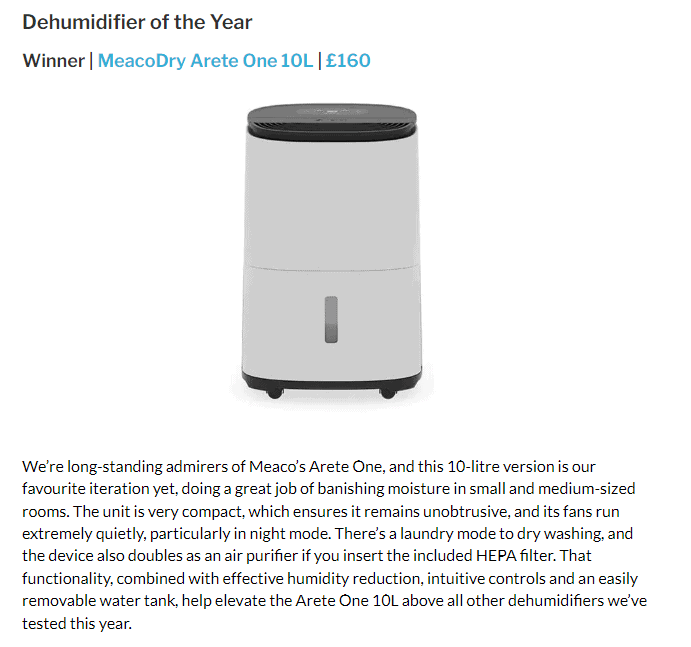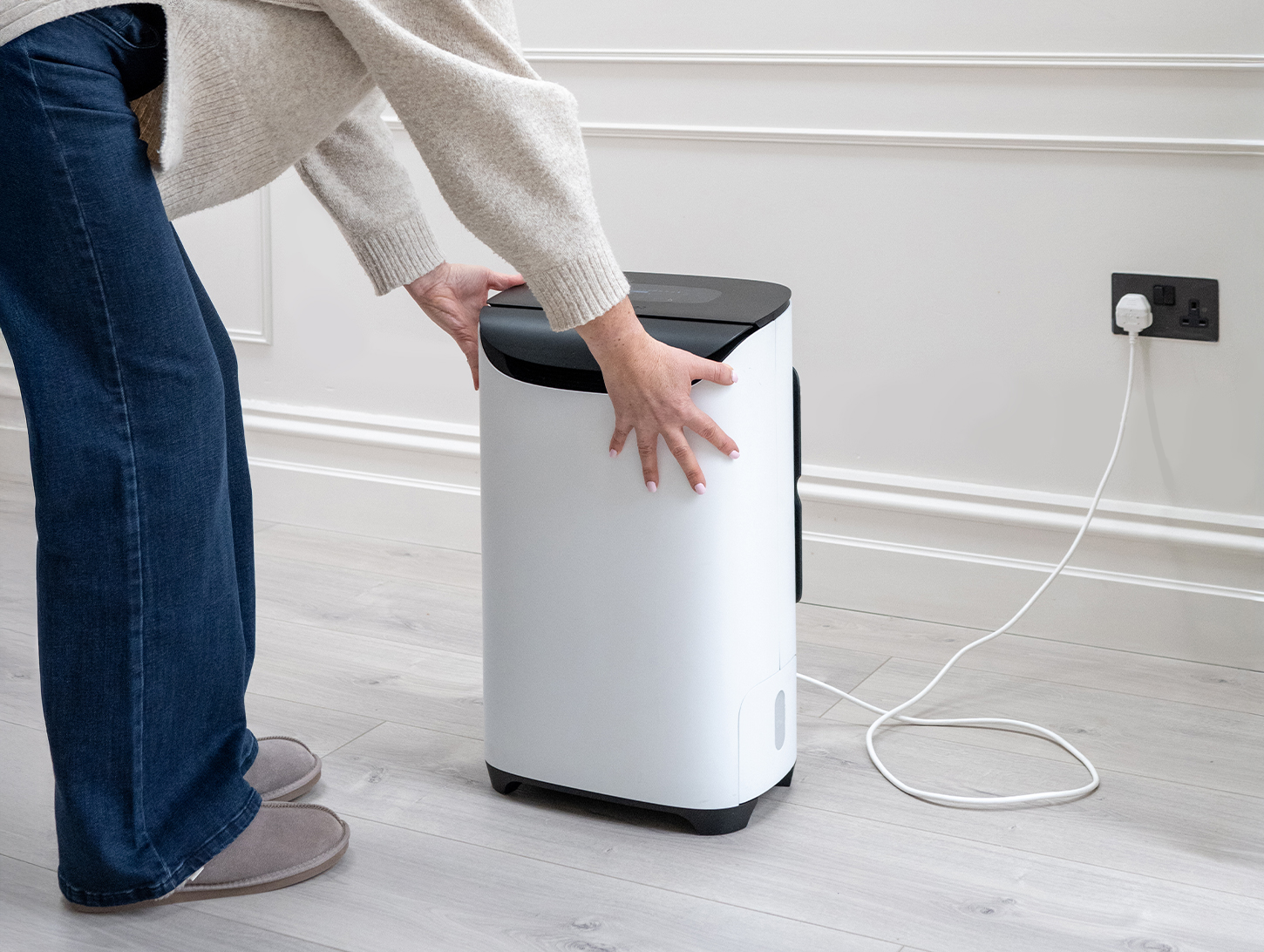Mould and condensation are often a cause for concern at this time of year, with more rainy and colder days our priority is to keep our homes warm and comfortable to live in. One way of preventing mould, condensation and damp inside your home is by using a dehumidifier, but with so many options on the market it’s important to make sure you are buying one that will not only help combat the problem of excess humidity, but which also has a long lifespan.
Before buying your dehumidifier, we recommend that you look for tell-tale signs of excess moisture in your home as there are always clear indicators of high humidity; for instance mould on walls, condensation on the windows, or musty smells to name a few.
Things to think about when choosing your dehumidifier:
How many rooms does your house have?
Firstly, you will have to understand the size of the house and which dehumidifier to use according to this – usually near the kitchen or just outside the bathroom with the door open are the more humid areas.
Will you want to move your dehumidifier around? If so, a dehumidifier with wheels is probably preferable. Are you using it in a small flat or home? A more compact dehumidifier would work for this, like our MeacoDry Arete 12L with its small, lightweight and compact design complete with castors.
When considering which dehumidifier to buy, you might want to think of the size of your house and read the specifications of the dehumidifier you want to buy (ours can be found in the instruction manual or on the technical overview tab on each product page).
Up to 2 bedroom flat/house | Up to 3 bedroom house | Up to 4 bedroom house | Up to 5 bedroom house or townhouse | |
Slightly damp 50%-60% relative humidity Light mould/condensation | 10L | 12L | 20L | 20L |
Moderately damp 60%-70% relative humidity Musty smells/regular mould/condensation | 12L | 12L | 20L | 25L |
Very damp 70%-80% relative humidity House always cold/mould & condensation in multiple rooms. Drying washing. | 12L | 20L | 25L | 25L x 2 |
Wet 80%-100% relative humidity Condensation on walls, mould on furniture/clothes. | 20L | 20L | 25L x 2 | 25L x 2 |
Energy efficiency
With high energy bills affecting us all these days, we are always looking for ways to reduce our electricity bills. When buying a dehumidifier, it’s important to consider the running cost over the initial price of the unit as it could save you a lot of money in the long term.
None of our products are energy draining products, in fact we have the most energy efficient range of dehumidifiers in Europe and we are proud to be leading the way in low energy dehumidifiers. That is why we encourage our customers to always look at all the technical information when buying any electrical product, as you could save yourself hundreds of pounds every year in energy consumption.
Read more about how buying a Meaco dehumidifier could save you over £700 in 5 years.
For Meaco, being transparent with our customers is our priority. We are more transparent than anyone else in the industry, that’s why the running costs are available for each model on the Technical Data tab on each product page. For more product specific details, please refer to the product page.
Will you be using your dehumidifier to dry your laundry?
Smaller flats or homes usually don’t have room for a tumble dryer, so the laundry tends to be hung to dry on a drying rack, the radiator or the back of chairs. In the colder months we keep our windows closed to prevent the heated air from escaping.
This results in the moisture from the clothes staying inside the home and the relative humidity starts to build up. Mould and condensation will then appear on cold surfaces around the home, on your windows or north facing walls.
If your flat or home doesn’t have an extractor fan in the bathroom or in the kitchen above the hob, the build up of humidity will be even worse.
Desiccant or compressor dehumidifier?
Another feature to consider when buying your dehumidifier is whether you want a desiccant or compressor dehumidifier. For a cold room (below 10°C) , you will want to buy a desiccant dehumidifier. For use in a warm room, the compressor dehumidifier is better for you.
Desiccant dehumidifiers are lighter and quieter in their low fan speed. They have a heater inside and they have a consistent performance regardless of the temperature; the air released from the desiccant dehumidifier is around 10-12°C warmer. So they are better if you’re using it in a cold hallway as they’ll warm the space up.
Compressor dehumidifiers work better in spaces that are already warm, above 10°C, if you are using a large compressor machine (20/25L) or above 16°C for a smaller compressor dehumidifier (10/12L). If you’re using it in a room that’s already nice and warm, the compressor is the best and will release air that is around 2°C warmer and will use less energy.
Look for customer reviews or press reviews
As with all purchases, it’s always best to have a look at reviews written by other customers or articles by press reviews or other product testing companies. Not only will they reveal the benefits of using the product, but it might also help give an idea on where to use it.
We are very proud to have won many awards for our dehumidifiers, notably Which?, Good Housekeeping Institute and QuietMark, but the great feedback that we receive on a daily basis about our dehumidifiers and the support from our customer support team. Reviews will always give you a more objective opinion and more detailed idea of your product. Our reviews can be found under ‘reviews’ on the product pages.
Have a look at one of our recent press reviews of our MeacoDry Arete from Expert Reviews (which won dehumidifier of the year!).








94 responses
Hi
My daughter lives in a bachelor flat (one room containing the bedroom and kitchenette = 4 x 5 metres, and separate bathroom/toilet – 2,4 x1,6 metres. She is experiencing a lot of mould creeping in every where (i.e. behind photo frames, inside cupboards, behind the bed, etc). The walls are not wet inside but the flat is expose to a lot of direct rain on the outside. Would your 10L dehumidifier be sufficient?
Helba
Helba,
Thank you for your enquiry.
Yes a 10L dehumidifier is more than powerful enough for your daughter’s space, in fact, it’s capable of tackling moisture issues in a two-bedroom apartment, so it will be ideal for the space you’ve described. Just one thing to keep in mind – during the colder winter months, it’s important that the dehumidifier is used in a reasonably warm environment with some heating on. Without warmth in the air, all refrigerant dehumidifiers struggle to extract moisture effectively.
So as long as that’s considered, it should work very well in controlling the mould.
I hope that helps,
Omar@Meaco
Hi, could you please advise to choose 12L or 20 L Arete. End of tarrace 3-bedroom house east/west side facing. Bedrooms and bathroom are upstairs. Living room, corridor, kitchen and shower room are downstairs. We keep our temperature around 20-21deg. There is condensation on the windows in the morning and seal can get mouldy if unchecked. We have been living in this house for 3.5 years and last year for the first time we started to notice some mould appearing on the wall by the windows on the east side only. We drying laundry inside in cold months but planning on getting a dryer asap. I would expect we’re still going to dry about 5-10% of our washing (2adults and 2kids) so laundry mode is important. Would 12L Arete left in corridor downstairs be sufficient? Or shall we opt for 20L? Thank you so much!
Thank you for your enquiry and for the information about your home,
Seeing as you are experiencing condensation and mold already plus the build up of moisture with drying your laundry and number of occupants, you’d have a more positive experience using a 20L.
I’d recommend using the: https://www.meaco.com/products/meacodry-arete-one-20l-dehumidifier-and-air-purifier
Hope this helps.
Omar@Meaco
Thank you, Omar. That’s helpful!
Advise needed which one will help
We live in a 3 bedroom mid terrace built pre 1890 mould around window frames in 2 bedrooms
Condensation on windows in mornings (bedrooms x3 all upstairs, bathroom ) plus kitchen most morning when Temperature goes below 7c outside on chill nights
Would also like to dry cloths on a air rack overnight
Which would you suggest and size
Rob,
Thank you for your enquiry, at those temperatures we can narrow down to three options, which are desiccant dehumidifiers.
There are x3 different types of desiccant dehumidifiers available, they are as follows:
• Meaco DD8L Junior Dehumidifier
• Meaco DD8L Dehumidifier
• Meaco DD8L Zambezi Dehumidifier
The Meaco DD8L Zambezi Dehumidifier is the more technical desiccant , offering features like on and off timers and a display to screen to see the humidity levels. Our other desiccants are the DD8L’s.
To provide more information on the differences please click here: https://blog.meaco.com/differences-dd8l-dd8l-zambezi/
Any of the above would be suitable to do the job. I hope this helps.
Omar@Meaco